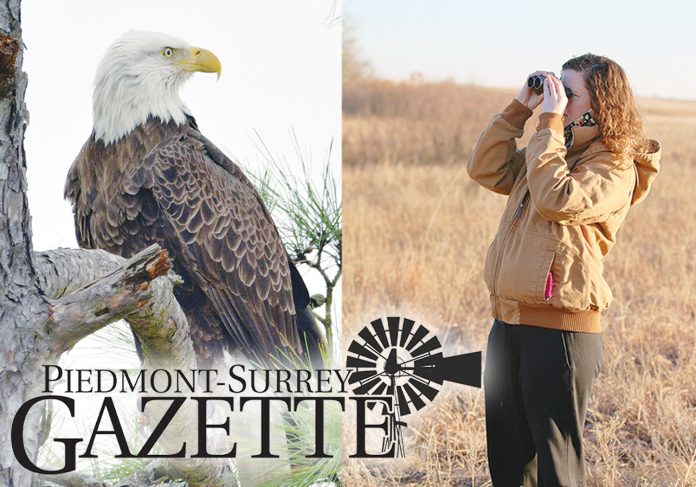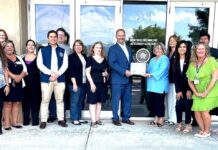
By Carol Mowdy Bond
Contributing Writer
Bald eagles are living at Fort Reno. And if you keep an eagle eye out, you may spot them. That’s exactly what El Reno’s Dr. Caitlin Rottler has been doing. A scientist, Rottler, who is a Research Fellow with the USDA Agricultural Research Center and the USDA Southern Plains Climate Hub, works from her office at Fort Reno. She’s spotted several bald eagles in the Fort Reno area in the recent past. As a self-proclaimed incidental birder, because her career doesn’t allow her the time to get really serious about bird watching, she’s totally wild about the frequent fliers.
Rottler knew if there were eagles, there must be an eagle nest. So, she made plans to find the nest and the bald eagles. Together with her friend Ann Marshall, who is the education coordinator at BlueSTEM AgriLearning Center located at Fort Reno, the two set out on a Friday afternoon trek in January.
Rottler had her binoculars and Marshall had her camera. They found the eagle nest in a tree in a Fort Reno pasture. The tree was situated along a stream flowing out of the North Canadian River. Of the nest, Rottler said, “It’s made of sticks. It’s not the biggest I’ve ever seen. I’d guess this one is about average size. We saw the nest, but no one was home!”
Of all eagle species, the bald eagle is only found in North America. As a bird of prey, they are one of the largest raptors with wing spans of 5.5 to about 8 feet. They stand 28 to 38 inches high. The females are 25% larger than the males, and usually weigh 10 to 15 pounds. The males weigh 6 to 9 pounds. The life expectancy is 16.5 years. Their only natural enemies are bears and wolves.
The bald eagle’s meal of choice is fish, so you’ll often find them living near water. But they’ve been known to eat just about anything including birds, mammals, turtles, crabs, shellfish, and more.
Sometimes a pair will mate for life. And both the male and female build the nest, which is called an aerie. They use sticks to build the nest, and line it with finer and softer materials such as feathers and grass. The average nest is 4 to 10 feet in diameter, and about 2 to 8 inches high. Both parents incubate the eggs, usually one to three eggs, during a period of 34 to 36 days. And bald eagles often reuse their nests for many years. In so doing, each year they add to the nest, which adds 1 to 2 feet in height to the nest annually, causing the nests to become huge. The largest nest found was in Florida, and it tipped the scales at about 3 tons. It was 9.5 feet in diameter, and 20 feet deep.

As a child, Rottler’s family took a lot of car trips across the U.S. Prone to car sickness, Rottler spent most of her time looking out the window so she wouldn’t get sick. Fighting boredom, she began watching birds. And soon she was hooked on the feathered wonders.
Rottler said she first became really excited upon seeing a scissortailed-flycatcher in Texas. She thought birds with such long tails lived only in tropical areas. It was a pivotal moment, causing her to become a life-long bird lover.
Now Rottler, passionate about all wildlife, is known to pull over and move a turtle out of the middle of the road so a car won’t run over it. And she keeps a pair of binoculars in her car console at all times. She sees birds, and accidentally runs her car off the road, trying to see what kind of birds they are. She’s been known to pull over quickly and slam on her breaks when sighting an unusual bird.
She’s seen Andean condors during two visits to Argentina, and said those were two of her most thrilling bird sightings. The first sighting happened really fast. But on the second visit, the condor flew really close. Andean condors are the second largest flying bird in the world. As scavengers, they’re part of the vulture family. Weighing up to 33 pounds, their wing spans can be up to 10.5 feet which is about the size of a compact car.
The puffin is the funniest bird Rottler has ever seen. She was in England at the time, and said when they fly, puffins look like flying footballs. They make funny noises and are just about as funny looking as a bird can be.
Rottler hopes to plant native plants in her yard at some point. She’s read studies that show native birds are on the decline. They eat native plants, and people are adding non-native plants to their landscaping. She encourages anyone who enjoys watching birds to do so, whether they just do so periodically, or as a full-time hobby.
“One thing I find most helpful for new birders is ‘Birding Ethics,’ because if you’ve not birded before, you might not realize there are some things you should and shouldn’t do (like playing bird calls on your cell phone),” Rottler said. “Following Birding Ethics ensures that both the people and the birds are safe and sound and happy. There are also some good phone apps for birding, which are great if you have a phone but don’t have a field guide and don’t want to buy one.”
You can check out the list of Birding Ethics online at www.aba.org/aba-code-of-birding-ethics/. Rottler is also a fan of the American Birding Association, and that website is www.aba.org. “For birding around the central part of the state, the OKC Audubon Society is a great resource. They’re still doing field trips. Check out their website at okc-audubon.org. There are also bird watching Facebook pages. But don’t let the hardcore birders make you feel badly. If you enjoy watching birds, even at your leisure, do it!”





